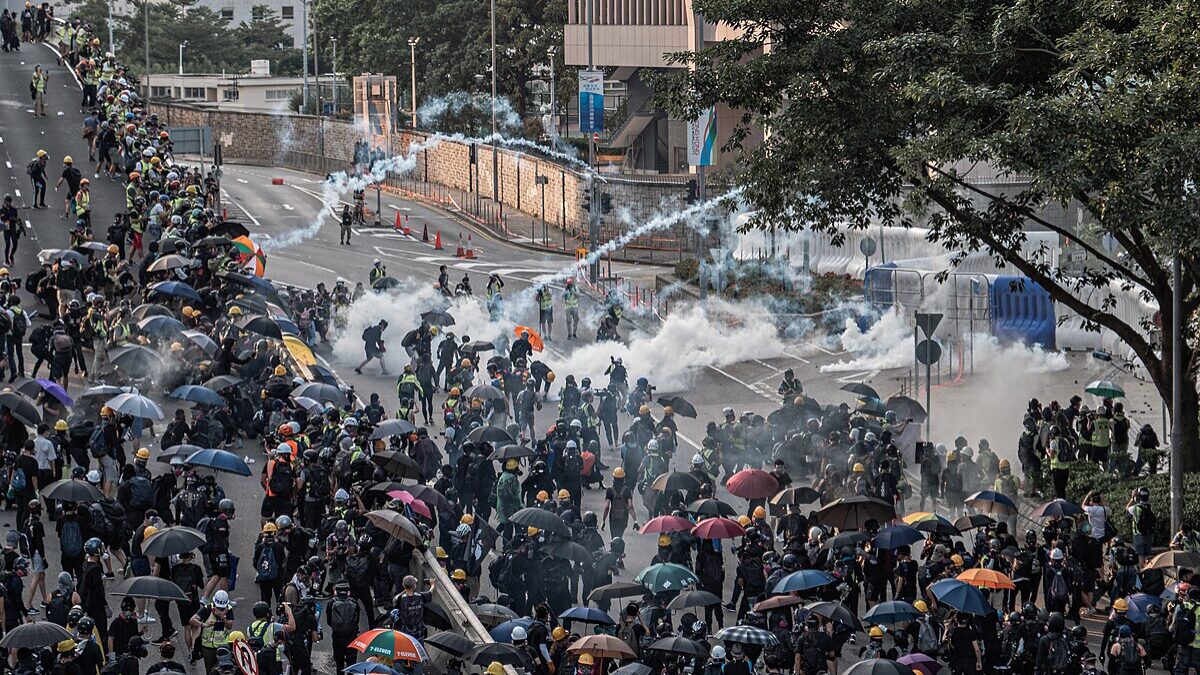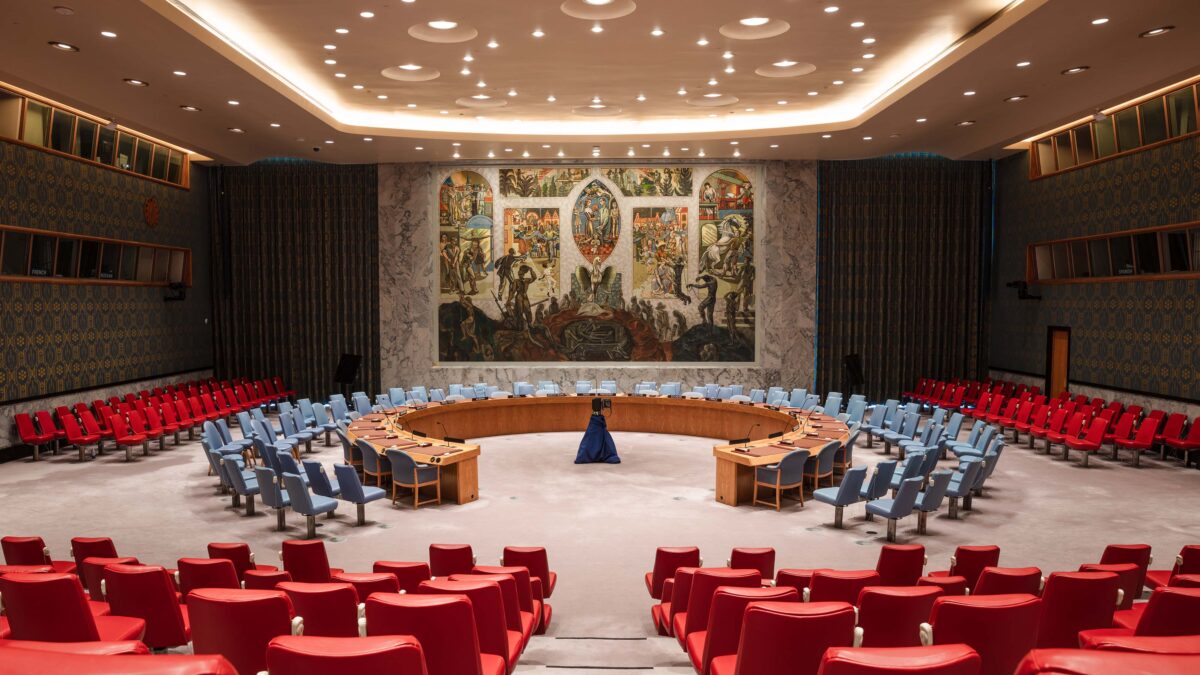The Biden administration has begun to waver in its support for Israel’s war against Hamas. President Biden warned this week that Israel was losing global support because of its “indiscriminate bombing.” A few days earlier, Vice President Harris said in Dubai that “too many innocent Palestinians have been killed” and admonished Israel to “do more to protect innocent civilians.” Secretary of State Antony Blinken and his British counterpart Lord Cameron have repeatedly warned that Israel must pursue its military campaign “consistently with international law.”
Israel, however, would strike a victory for the West and its values by ignoring these vague demands to follow international law. Jerusalem would strike a victory for the Western democracies not just in defeating Hamas on the battlefield and driving it out of Gaza. It would also achieve success in rejecting the cynical legal and political campaign of terrorist groups, their nation-state backers, and the “useful idiots” who sympathize with them. These groups, aided and abetted by a broad network of non-governmental organizations, seek to turn the West’s moral and legal principles against itself to make effective self-defense impossible.
The Israel Defense Forces, or IDF, is now confronting the most difficult challenge in its campaign as it enters Khan Younis, a dense city in the southern Gaza Strip that is home to Hamas’ leadership. After urging Palestinians to evacuate northern Gaza and clearing its major cities of terrorists, Israeli units must now root out Hamas in the south, where most of the 2.3 million Gazans have fled. Casualties among civilians and combatants will rise still higher as Hamas continues to use Palestinians as human shields to protect its network of underground tunnels and its above-ground facilities, often hidden inside schools, mosques, and hospitals.
International Law and Civilian Casualties
But what international law actually requires is very much in dispute. It’s one of the urgent questions raised by the conflict in Gaza: Does international law impose such severe restrictions that a terror force, by hiding behind civilians, can prevent a Western army from defeating it?
Western strategists were not always so sensitive to civilian casualties. In the weeks before and after the Normandy landings in 1944, Allied bombers attacked infrastructure across northern France to obstruct German troop movements — and to fool the Germans about the ultimate location of the main Allied invasion. Some 50,000 French civilians were killed in these air attacks. But the French accepted these unintended (though foreseeable) losses as part of the price for driving the German army from France.
Modern weapons allow for more precise targeting. But modern conflicts have also seen enemies resort to hiding fighters and weapons in places where civilians are concentrated, such as hospitals, schools, and mosques. When ISIS took over the Iraqi city of Mosul in 2016, the U.S. gave extensive air support to Iraqi efforts to liberate the city. After months of fighting and bombing, more than 3,000 civilians had been killed in air and artillery attacks (according to a 2017 study by the Associated Press). The civilian population in Mosul was about half that of Gaza, and large numbers of civilians were able to flee (while Egypt has refused to accept any substantial number of Gazan refugees). In proportion to the number of civilians at risk, the relief of Mosul certainly unleashed harm to civilians on a scale somewhat comparable to that in Gaza.
Of course, one could say Iraq was only reclaiming its own country. Much of the world sees Israel as a Western implant in the Middle East, suppressing the rightful claims of Palestinians. U.N. delegations have had years of practice voting routine resolutions of condemnation against Israel, long before the current land war in Gaza. Even in Western countries, many people acknowledge that Israel has a right to defend itself against terror attacks, but worry that the cost in Palestinian lives is out of proportion to the goal of Israel’s full security. We cannot be sure how much peace or security the destruction of the current Hamas authority will bring in the future. These difficult moral questions are an inherent feature of war, both in legitimacy and conduct.
Israel’s critics would rather ignore the moral challenges and claim that its campaign in Gaza violates international law. But the relevant international law is much disputed. Imagine that today’s U.N. General Assembly, which just called for a ceasefire by 153-10, and in the past declared Zionism to be racist, were asked to draw up standards for armed conflict. That is, in fact, what happened.
After the Second World War, the victorious Allies had no intention of condemning their own practices. The 1949 Geneva Conventions merely elaborated “humanitarian” protections for prisoners of war, wounded and shipwrecked combatants, and civilians in occupied territories. The Geneva Conventions did little to regulate the conduct of hostilities, which for the most part have long followed a set of unwritten “customary” principles.
During the Vietnam War, communist and Third World countries urged that the U.N. condemn what were depicted as U.S. war crimes. Western states, seeking to avoid the confrontational political atmosphere at the U.N., persuaded the Red Cross to convene a new drafting conference in Geneva. But all the members of the General Assembly participated in the deliberations, along with “observers” from the Palestine Liberation Organization and the African National Congress (then a terrorist organization fighting the apartheid government of South Africa).
The resulting treaty — Additional Protocol I to the Geneva Conventions (1977) — provided new protections for guerilla forces. The traditional understanding, codified in the Hague Convention of 1899, protected civilians by requiring soldiers to identify themselves with uniforms and insignia and carry arms openly, so enemy forces could limit their attacks to actual combatants. AP I treated guerilla fighters as lawful combatants so long as they showed their weapons just before they attacked, allowing them to disguise themselves as civilians and hide among innocent populations to confuse the regular troops fighting them.
AP I further sought to constrain advanced military forces by limiting legitimate targets. It declared that attacks even on legitimate military targets must not cause incidental harm to civilians that would be “excessive in relation to the concrete and direct military advantage anticipated” from the attack. The same provision (Art. 51) cautions that belligerents “shall not direct the movement of the civilian population … in order to attempt to shield military objectives from attack …” (Par. 7) But AP I immediately follows this caution with the admonition that violations of this prohibition do not “release the parties to the conflict from their legal obligations with respect to the civilian population ….” — thereby assuring that the ostensibly prohibited tactic of hiding behind civilian shields will still work. AP I declares that states have a duty to punish “grave breaches” of the convention, among which it lists attacks that yield excessive harm to civilians — but not maneuvers to deploy civilians as human shields.
Britain and France declined to ratify AP I for more than two decades — that is, until well after the end of the Cold War. The United States, Israel, and a number of other countries still have not ratified. But language from AP I was adapted for the criminal tribunal established by the U.N. to restrain combatants in the conflicts arising from the break-up of Yugoslavia (ICTY, 1991) and then again in the more ambitious International Criminal Court (ICC, 1998).
The ICC embraces the same priorities as AP I: The ICC can prosecute states that incur “excessive” civilian casualties in their attacks but cannot punish the deployment of weapons or fighters behind human shields. It does, on the other hand, include, among “war crimes” that can be prosecuted, “the transfer, directly or indirectly, by the Occupying Power of parts of its own civilian population into the territory it occupies … ” — to allow the ICC to prosecute Israeli officials for allowing their citizens to build homes in disputed territory in East Jerusalem or elsewhere in the West Bank (or at the time, in Gaza).
Both the United States and Israel insist that their armies are bound by restraints recognized in the “customary law” of armed conflict, which overlaps with provisions in AP I and earlier treaties. But this still leaves much room for disagreement.
The International Committee of the Red Cross published a commentary in the mid-1980s that insists that AP I leaves no “justification for attacks which cause extensive civilian losses and damages. Incidental losses and damages should never be extensive.” By contrast, the Law of War Manual issued by the U.S. Department of Defense in 2015 holds that “a very significant military advantage would be necessary to justify the collateral death or injury to thousands of civilians.” Still, it regards this sad outcome as potentially quite lawful: Determination of compensating “military advantage,” it cautions, is “a highly open-ended legal inquiry and the answer may be subjective and imprecise.” The manual explains that “military advantage” need not be “immediate” and must be judged in the context of an entire campaign “rather than only from isolated or particular parts of the attack.”
Military Advantage vs. Incidental Civilian Damage
There are so many uncertainties packed into the AP I formula that no international tribunal (neither the ICC nor its predecessor criminal tribunal for former Yugoslavia) has ever attempted a prosecution for violating “excessive” harm in relation to “the military advantage anticipated.” The formula is particularly hard to apply here, when casualty reports are based on notoriously unreliable claims by the Hamas-controlled public health authorities in Gaza, which had falsely claimed that Israel had bombed the Al Shifra hospital in the opening days of the war. Those who do not fight wars cannot reliably judge, after the fact, the balancing of military advantage against incidental civilian damage that Israeli commanders on the ground had to act on in the heat of battle.
Demands that Israel, and, by extension, the United States, obey impractical rules of warfare constitute a form of politico-legal attack on the West. Such standards would invite terrorists — and hostile nations like Russia, China, and Iran — to fight by targeting civilians while handicapping the ability of Western nations to respond effectively.
Consider Hamas, which succeeds by blatantly violating the rules of war. Its fighters neither wear clear uniforms nor operate in open, clear military formations. Hamas instead hides its personnel and assets among and behind civilians. It broke the fundamental principle of the laws of war by attacking a large music festival and undefended villages on Oct. 7. Hamas succeeds precisely by blurring the line between combatants and non-combatants, both on its own part and that of its victims. Extending legal protections to Hamas only multiplies its incentive to continue violating the basic principles of humane combat.
Hamas’ conduct makes its threats to civilized warfare especially dangerous. Not only does it target the innocent and use civilians as shields, but it deliberately invites attacks on its own population. Hamas sought to prevent Gazans from complying with the Israeli warnings to evacuate north Gaza. Video of civilian deaths raises Hamas’ standing within the Arab world and increases the political pressure on the United States to restrain Israel. Humane limitations on the conduct of war cannot apply perfectly to wars with an irregular enemy that deliberately uses its own civilian population as a human shield. To restrain Israel from succeeding in its war means incentivizing terrorists to adopt the same practice in future conflicts.
Harm to Palestinians is tragic, but it is a tragedy authored by Hamas in violation of the civilized rules of war. Leaving Hamas in power may open the door to greater tragedies — and not only in Gaza.









